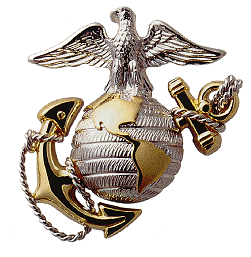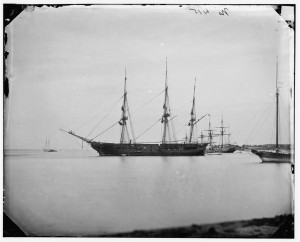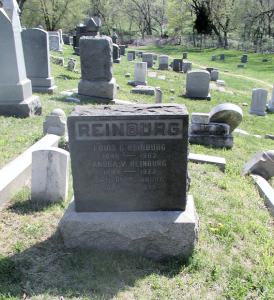 On Navy Day, 1928, my father, a U.S. Coast Guard commander, took my older sister and me to the Washington Navy Yard to hear President Calvin Coolidge give an address to Navy dignitaries and guests. As we passed through the gate, a tall, broad-shouldered man in uniform saluted my father and motioned us through the gate. I was very impressed with this important-looking person and asked my father who he was. He said, “That’s a hard- boiled, topkick Marine.” As an afterthought, as we drove off, he started talking about his father, who was born in 1847 and joined the U.S. Marine Corps shortly before the Civil War. Although my memory is a little hazy about the conversation (I was only six years old), I do remember that he said his father had received a commission in the U.S. Navy during the Civil War. I don’t remember what the President spoke about that day at the Navy Yard, but I do remember that he spoke from one of the upper decks of what I thought at the time was a very large, gray Navy ship, to a crowd of people, most of whom were in uniform, seated, or standing on the dock.
On Navy Day, 1928, my father, a U.S. Coast Guard commander, took my older sister and me to the Washington Navy Yard to hear President Calvin Coolidge give an address to Navy dignitaries and guests. As we passed through the gate, a tall, broad-shouldered man in uniform saluted my father and motioned us through the gate. I was very impressed with this important-looking person and asked my father who he was. He said, “That’s a hard- boiled, topkick Marine.” As an afterthought, as we drove off, he started talking about his father, who was born in 1847 and joined the U.S. Marine Corps shortly before the Civil War. Although my memory is a little hazy about the conversation (I was only six years old), I do remember that he said his father had received a commission in the U.S. Navy during the Civil War. I don’t remember what the President spoke about that day at the Navy Yard, but I do remember that he spoke from one of the upper decks of what I thought at the time was a very large, gray Navy ship, to a crowd of people, most of whom were in uniform, seated, or standing on the dock.
Over the ensuing years, I remember my father speaking of his father from time to time, but other than saying on one occasion that my grandfather had commanded a ship during the Civil War on which his own father was serving as a master’s mate, not very many details were mentioned. My mother died at the age of 39, in 1939, when I was in high school, and my father never remarried. Later, I entered the Coast Guard Academy, my father retired in 1946 as a Rear Admiral, and I was commissioned an Ensign in 1948. I was a severe blow to me when my father died in 1956. I thought of so many things I wanted to talk to him about, but although we kept up a lively correspondence over those years, I was stationed on the West Coast and Alaska, while he had retired to the home he had built in Washington, D.C. My opportunities to visit with him were limited; I was able to get home on leave only twice after I graduated from the Academy. Once, when my ship was tied up at the U.S. Naval Station, Adak, Alaska, I phoned him. He had been on the Bering Sea Patrol before World War I, and I had a hard time convincing him that I was calling from Adak. Adak was an Aleut village of a few dozen people when he was last there in 1923 when I was born.
It was only after my father’s eldest sister died in 1962, and I was helping her husband, my uncle, sort through her effects that I discovered a document titled “Military and Naval Record of Louis Reinburg,” her father and my grandfather. It was the first confirmation in writing I had seen that my grandfather was indeed a Marine. He enlisted in the U.S. Marine Corps as a boy, ten years of age, on August 29, 1856. He reenlisted at Washington, DC, on October 13, 1860; was honorably discharged at Washington, DC, October 9, 1863; was appointed Mate, U.S. Navy, November 28, 1863; and was honorably discharged February 8, 1868 at the age of twenty-two, with twelve years service!
Before the outbreak of the Civil War, Louis Reinburg served at the Philadelphia Barracks on the USS Jamestown; at the Washington, DC, Barracks; and on the USS Plymouth. He manned Fort McHenry and Fort Washington, Maryland, until relieved by the regular garrison. He was transferred to the USS Pawnee, March 4, 1861, and sailed to relieve MAJ E.A. Anderson at Fort Sumpter. He was at the burning of the Norfolk Navy Yard in 1861, and also in the fights at Aquia Creek and Mathias Point. He was transferred to the USS Sabine in 1861 and served blockading duty off Charleston, SC, and rescued shipwrecked Marines before the assault on Port Royal. (His vessel was too large to cross the bar.)

USS Sabine (photo from Library of Congress collections)
Louis Reinburg was “invalided” to the Brooklyn, NY, Hospital, in 1862, after having been wounded in action. After recovering from his wounds, he was transferred to the USS Brandywine before being honorably discharged from the Corps, and appointed Mate, U.S. Navy. He served as Mate on USS Teaser, USS Wasp, and USS Supply, and participated in all engagements and skirmishes of the “Potomac Flotilla,” from February 28, 1863, to the end of the war. At the end of the war, he was honorably discharged, with the thanks of the Navy Department, February 8, 1868, upon returning from the “Brazilian Squadron” on the USS Supply.
Also in Louis Reinburg’s record was a resolution of thanks of the U.S. Congress to Commodore Cadwaladar Ringgold and the officers and crew of the United States Ship “Sabine.” The resolution read
That the thanks of Congress are hereby tendered to Commodore Ringgold, the officers, petty officers, and men of the United States Ship “Sabine,” for the daring and skill displayed in rescuing the crew of the steam transport “Governor,” wrecked in a gale on the first day of November, eighteen hundred and sixty-one, having on board a battalion of United States Marines under the command of Major John G. Reynolds, and in search for, and rescue of the United States line-of-battle ship “Vermont,” disabled in a gale upon the twenty-sixth of February last, with her crew and freight.
Sec, 2. That the Secretary of the Navy be directed to communicate the foregoing resolution to Commodore Ringgold, and through him to the officers and men under his command.
Approved March 7th, 1864.
If such could be possible, my sense of pride in the United States Marine Corps increased after reading of my grandfather’s exploits in that service. I say this because I have always admired the Corps, but knowing that I am a direct descendant of a Marine has made me aware of a kinship that I will always treasure. Just recently, my good friend Captain Sam Collins, U.S. Navy (Ret.) told me that when he is at a function where the Marine Corps Hymn is played, he looks around at the audience, and if he does not see a Marine standing, he stands. I wonder if the Marines would mind if I did the same to show my admiration for that magnificent service.

